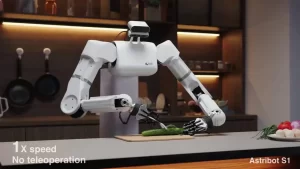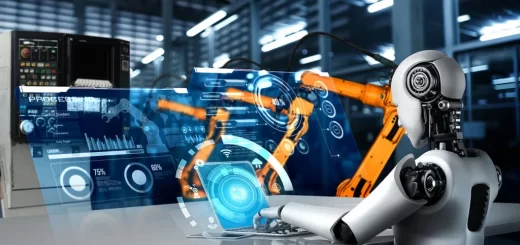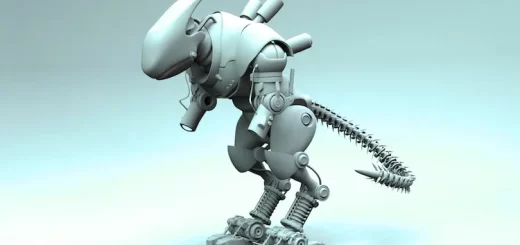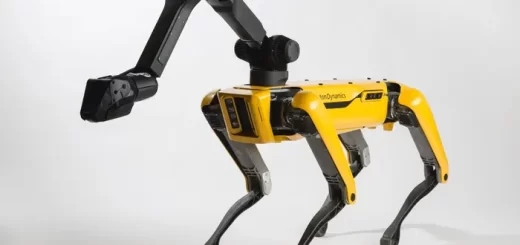Astribot S1 review, advantages, disadvantages and features
The Astribot S 1 is a recent advancement in humanoid robots. The S 1 boasts impressive speed and precision. it can perform tasks like opening a bottle, shaving a cucumber, and writing calligraphy with remarkable dexterity.
Astribot S 1
The Astribot S 1 is a recent development in the world of AI robots, taking the spotlight for its impressive speed and precision. Astribot claims the S 1 operates entirely autonomously, without the need for teleoperation (remote control). This is a significant step forward if true.
The Astribot S 1 boasts a top speed of 10 meters per second, which is roughly 22 miles per hour! This makes it significantly faster than most other humanoid robots. The Astribot S 1 can perform intricate tasks with remarkable accuracy, from delicate calligraphy to flawlessly flipping a sandwich in a pan.
The Astribot S 1 seems adept at mimicking human movements, suggesting it can learn and adapt to new tasks. While the Astribot S 1 has generated a buzz, information about the company behind it and its functionalities remains somewhat limited. There’s no confirmation yet if it has a mobile base or operates solely with a stationary arm.
the Astribot S 1 might be fully autonomous, meaning it can operate without human control. This is a significant leap in humanoid robot development, but more information is needed for confirmation. The Astribot S 1 is a relatively new invention. While impressive, it’s likely still under development, and its commercial availability is yet to be determined.
the Astribot S 1 represents a significant advancement in AI robotics, Astribot S 1 presents a powerful new technology, It is a recent advancement in humanoid robots. The Astribot S 1 appears to be a significant leap forward in terms of speed, precision, and manipulation for humanoid robots.
Astribot S 1 AI Robot Advantages
Astribot S 1 boasts impressive speed, reaching up to 10 meters per second, and exceptional precision in its movements. Astribot S 1 can handle objects with delicate maneuvers, like opening a bottle, shaving a cucumber, or writing calligraphy.
AI robots like Astribot S 1 present a powerful tool with significant potential benefits. AI robots offer significant potential to improve efficiency, safety, and accuracy across various sectors.
AI robots can automate repetitive tasks, freeing up human workers for more complex or creative endeavors. This can boost productivity across many industries like manufacturing and logistics. AI robots are programmed to follow instructions meticulously, minimizing errors and ensuring consistent results, especially in manufacturing, surgery, and assembly lines.
Unlike humans, AI robots don’t require breaks or downtime. They can operate continuously, enabling round-the-clock operations or services. ideal for tasks that need constant monitoring or production. AI robots can handle dangerous environments that pose risks to human life, minimizing risks for human workers. They can be deployed in bomb disposal, deep-sea exploration, or radiation cleanup.
AI robots can analyze vast amounts of data much faster than humans. This allows them to identify patterns, predict trends, and provide valuable insights for better decision-making and improved processes. AI robots can perform tasks with high precision, reducing errors and improving overall quality control. This is crucial in delicate procedures like surgery or assembly line production.
Disadvantages of Astribot S 1 AI Robot
As AI robots become more sophisticated, they may replace human workers in certain jobs, leading to unemployment and economic disruption. Developing, installing, and maintaining AI robots can be expensive. This may limit their accessibility to smaller businesses or developing countries.
AI robots excel at following instructions but struggle with tasks requiring creativity, critical thinking, problem-solving in unforeseen situations, or adapting to changing environments or human-like social interaction and empathy.
AI robots are susceptible to hacking or malfunctions, which could have serious consequences depending on their function, potentially causing safety hazards or disruptions. Additionally, ethical considerations arise around robot responsibility and decision-making.
Biases in the training data can lead to discriminatory outcomes from AI robots. there are concerns about the development of autonomous systems. AI algorithms can perpetuate existing biases in data sets if not carefully designed, This can lead to discrimination and unfair treatment.
You can follow Science Online on Youtube from this link: Science online
You can download Science Online application on Google Play from this link: Science Online Apps on Google Play
Elias robot review, advantages, disadvantages, and What robot teaches languages?
Robot teachers use, types, advantages, and disadvantages
Educational robotics, Robot teachers, Social robots review, features advantages and drawbacks
Artificial intelligence in education, AI tutors features, advantages and disadvantages
Pros and cons of technology in education and Can technology replace teachers?
The importance and uses of educational robotics for students




